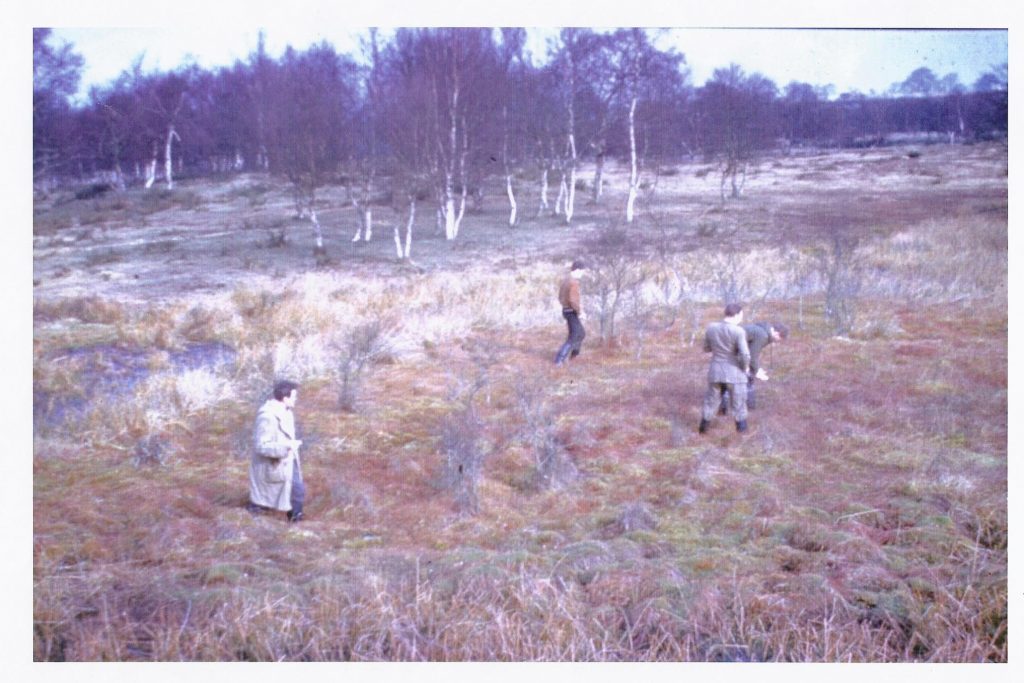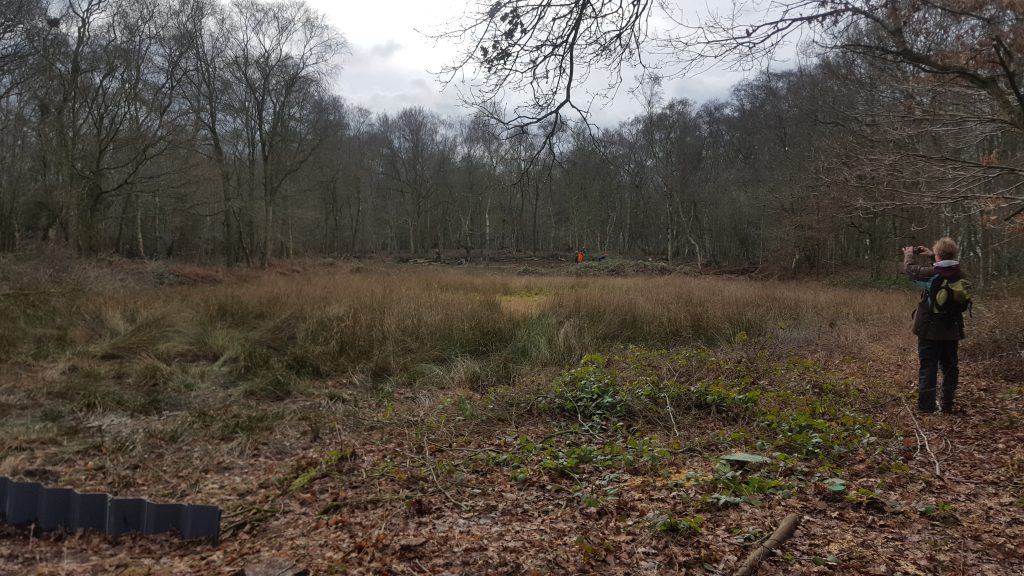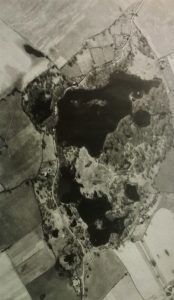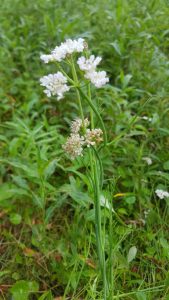Flagship Focus: Brown Moss update 2018
28th February 2018
We first introduced the Flagship Pond site Brown Moss in Shropshire, exactly two years ago. Since then so much has happened at this wonderful site, we thought it was time for a little update

The last few years have marked a significant change in the way Brown Moss is managed by owners Shropshire County Council, the work supported by Natural England and others. When we started the Flagship Ponds project in 2015, planned management work was well underway. This involved significant clearance of secondary woodland and scrub around the margins of around half of the pools on the site, and from one of the rarest features; a quaking bog know as a Schwingmoor. This is a very special habitat which was formed by sphagnum moss colonising, and gradually filling in one of the smaller pools – resulting in a floating raft of vegetation. For many years, concerns had been raised that the Schwingmoor was drying and being colonised by Silver Birch Betula pendula and Soft rush Juncus effusus. In an effort to address this sheet pilling was installed to retain water and prevent drainage. More recently the removal of a surrounding 10m halo of trees to reduce shading and uptake of water has taken place. Unfortunately the star species associated with this habitat type – Round-leaved Sundew Drosera rotundifolia – is no longer present at Brown Moss and was last recorded in 2001, adding to the increasingly long list of sensitive species which are now extinct from this site.
 Esteemed Shropshire botanist Charles Sinker (and his students) pictured here on the Schwingmoor in 1959 © Natural England archive
Esteemed Shropshire botanist Charles Sinker (and his students) pictured here on the Schwingmoor in 1959 © Natural England archive  Mags Cousins at the same area of the Schwingmoor in 2016 (c) Pete Case
Mags Cousins at the same area of the Schwingmoor in 2016 (c) Pete Case  Brown Moss as a far more open site with less tree cover and more open heathland. 1947 National Monument Record © Shropshire County Council archive
Brown Moss as a far more open site with less tree cover and more open heathland. 1947 National Monument Record © Shropshire County Council archive
The return of grazing animals to Brown Moss in November 2016 after many decades absence, was a landmark moment following years of unsuccessful attempts. A herd of Hereford cattle grazed the site well into spring of 2017. The long lack of grazing at Brown Moss explains why the site is now so wooded – aerial photos form the site from the 1940’s show far more heathland and less tree cover. To maintain the site in good condition for the long-term, grazing is an essential component of the management. Historically, local people turning out their animals onto the common would have helped to maintain the interest of the site, particularly around the pool margins and also the heathland/acid grassland.
 Tubular Water-dropwort (c) Pete Case
Tubular Water-dropwort (c) Pete Case
Following the recent management work, in 2016, a few plants of Tubular Water-dropwort Oenanthe fistulosa were found growing by Pool 5. Prior to this, the rare plant was last recorded in 2007 and despite extensive searches in the intervening years, was assumed extinct. The re-appearance of Tubular Water-dropwort is attributed to the recent management work, opening up the surrounding canopy, and the associated ground disturbance of the work being carried out. Amazingly, in 2017 when checking the same spot, 30 plants were recorded and the patch had spread to another area close by. The cattle had certainly spent time around the margins of pool 5, and had evidently poached the ground enough to suppress the more vigorous plants that would otherwise have become dominant. Pool 5 is now set up as a ‘focal pond’ for monitoring Tubular Water-dropwort and habitat, and will feed into the national PondNet survey for this priority species.
A similar positive story can be told for Pond Mud Snail Omphiscola glabra. This freshwater mollusc (also a priority ‘Section 41’ species) which is facing an uncertain future, is doing well at Brown Moss. Very little information existed on this species at Brown Moss prior to the Flagship Ponds project – just a casual mention in an old management plan of a single specimen from 1989. Following methodology designed by us for the PondNet survey, Natural England staff member and mollusc recorder for Shropshire, Mags Cousins, went about surveying all 13 pools which amazingly resulted in 7 pools supporting populations of this rare species! This is a very significant discovery and makes Brown Moss the county stronghold for this species – it is currently only known from one other site in Shropshire.
But there’s some worrying news too. For decades Brown Moss has suffered with invasive non-native plants. Both New Zealand Pigmyweed Crassula Helmsii and Water Fern Azolla filiculoides had been recorded, with Crassula thought to be limited to the main pool (pool 6) and outlying pool 10. Sadly in 2016 Crassula was found at another 4 pools which led to emergency spot treatment and digging out of some affected areas in an attempt to prevent further spread. This appears to have worked at pool 4, with extensive searches failing to relocate the plant, but Crassula is now well established in the remaining pools – something we have to live with. It is unclear how Crassula has spread to the new locations, one theory is that the plant may already have been present in low numbers, and the sudden influx of management provided the right conditions for the vigorous growth.
Another ongoing concern for Brown Moss is the loss of nutrient sensitive wetland plants. For example, indicator species like Pillwort Pilularia globulifera and Lesser Water-plantain Baldellia ranunculoides are no longer present. Water quality testing in the past has revealed high levels of phosphate in some pools, and nitrate in others. Through the Flagship Ponds project, a citizen science project was set up with students from local Harper Adams University to set up seasonal monitoring of water in all pools, ditches and inflows to the site. The final season (winter 2018) is being collected now, and the data will help to inform future measures to reduce nutrient inputs to the site from the surrounding catchment.
Finally, the Flagship Ponds project funded a seedbank assessment at the site to check for presence of Floating Water-plantain Luronium natans seeds – one of the rarest water plants in England and the primary reason the site is designated a Special Area of Conservation (SAC). Luronium was last recorded on this site in 2006 on pool 6. In June 2016 soil cores were taken from this location. The cores revealed that indeed the plants had set seed in the past, and two Luronium seeds were recovered and positively identified. Unfortunately further testing by staff at the Millennium Seed Bank at Kew revealed the seeds were damaged and not viable. However this is encouraging news and has prompted an experiment to scrape back sediment at the location and set up a series of pens to exclude livestock and waterfowl in the newly scraped areas in the that Luronium seeds will germinate. The experiment will test different hydrological gradients long the drawdown zone, and the response will be monitored by professional botanists over the coming years.
 Winter 2017: Pens to exclude grazing and wildfowl in the area scraped back to stimulate germination of Floating water-plantain. (c) Mags Cousins
Winter 2017: Pens to exclude grazing and wildfowl in the area scraped back to stimulate germination of Floating water-plantain. (c) Mags Cousins
It has been a pleasure to be involved at this wonderful site over the last three years and we thank all of the volunteers and professionals who have given their time and expertise to help with the Flagship Ponds project, and of course the Heritage Lottery Fund which has contributed funding. A newly established ‘Friends of Brown Moss’ group which is supported by Shropshire County Council, is looking for volunteers to help with ongoing practical management and monitoring at this wonderful site.
If you live locally and can spare some time, please contact Lee Fraser (Volunteer Coordinator) on Lee.Fraser@shropshire.gov.uk
